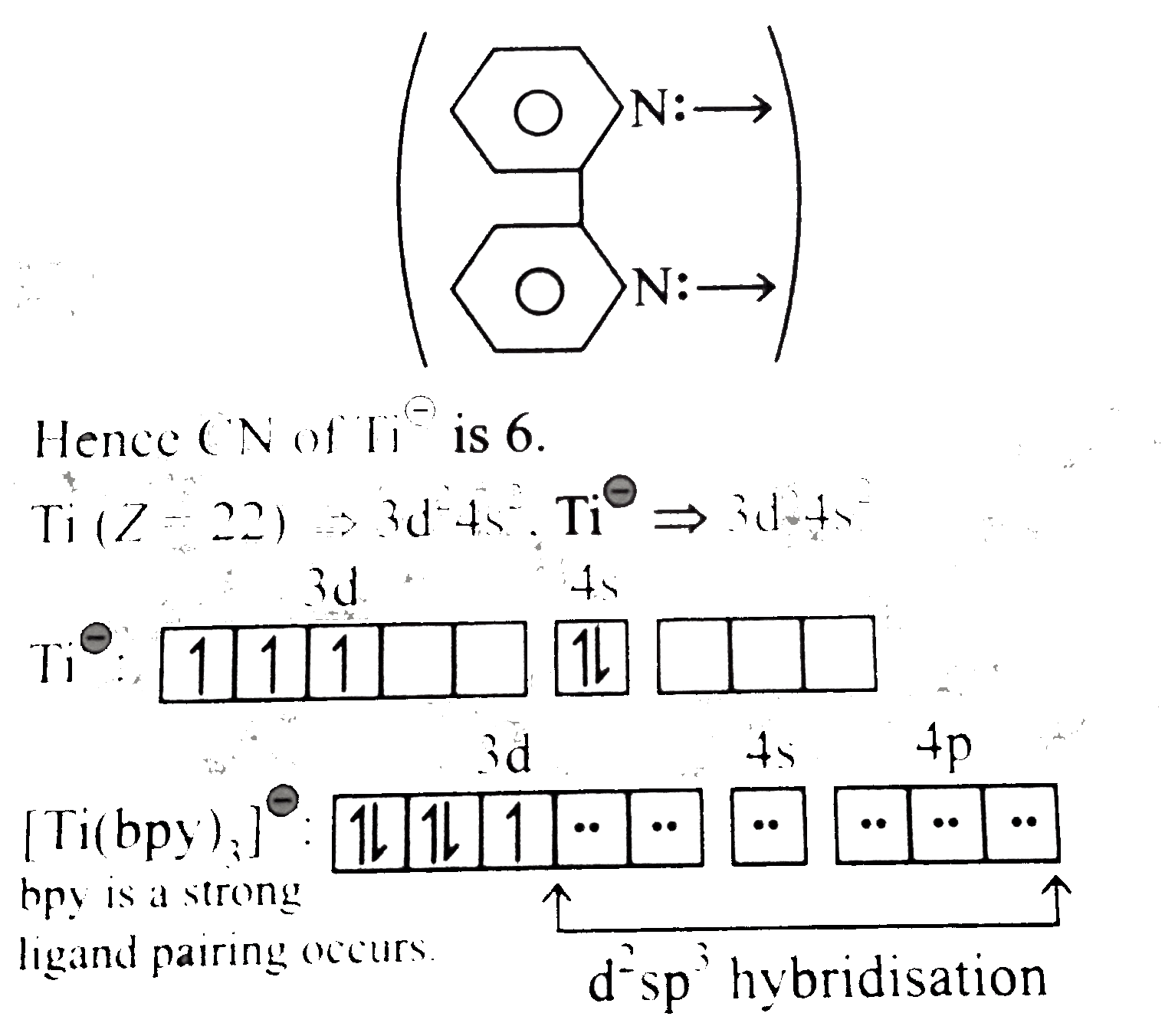One the basis of VBT answer the following complex ions
(i) [Ti(bpy)3]Θ
(b) [V(H2O)6]3+
(ii) [V(H2O)6]3+
(III) [Mn(CN)6]4−
[Mn(CN)6)]3−
(V) [Ir(NH3)6]3+ .
Type of hybridisation involed
(b) Type of inner or outer orbital octahedral complex
(c ) Magnetic behaviour and μsπn value .
Video Solution
Text Solution
bpy or dipy is a strong field neutral bidentage ligand

(a) d2sp3 hybridisation with OH shape
(b) Inner orbital complex
( c) Paramagnetic n=1
μspin=√3BM=1.732BM
(II) [V(H2_(o)]3+
V(Z=23)⇒3d34s2,V3+=3d24s0
CNΘ is a strong field ligand so pairing occurs

d2sp3 hybridisation with OH shape
(b) Inner orbital complex
(c ) Paramagnetic , n=2
(d) μ(spin)=√8BM=2.828BM
(III) [Mn(CN)6]4−
Mn(Z=25)⇒3d54s2,Mn2+=3d54s0
CNΘ is a strong field ligand so pairing occurs

(a) d2sp3 hybridisation with OH shape
(b) Inner orbital complex
(c) Paramagnetic n=1
(d) μsπn=√3BM=1.732BM
(IV) [Mn(CN)6]3−
Mn(Z=25)⇒3d54s2,Mn3+=3d44s0
CNΘ is a strong field ligand so only one pairing occurs

(a) d2sp3 hybridisation with OH shape
(b) Inner orbital complex
(c ) Paramagnetic n=2
(d) μspin=√8BM=2.828BM
(V) [Ir(NH3)6]3+
ir(Z=7)implies5d^(7) 6s^(2), Ir^(3+) = 5d^(6) 6s^(0)<br><imga≤ocr_imageload∈g=lazysrc=https://d10lpgp6xz60nq.cloudfront.net/physics_images/KSV_P2_CHM_C07_E01_045_S05.pngwh=80%mx-autosty≤=background:white;><br>(a)d^(2)sp^(3)hybrsation<br>(b)I∩erorbitalcomp≤x<br>(c)Diamag≠ticmu_("spin")=0 .
|
Updated on:21/07/2023
Topper's Solved these Questions
- BOOK - CENGAGE CHEMISTRYCHAPTER - COORDINATION COMPOUNDSEXERCISE - Ex 7.2 Objective8videos
COORDINATION COMPOUNDS
- BOOK - CENGAGE CHEMISTRYCHAPTER - COORDINATION COMPOUNDSEXERCISE - Exercises Linked Comprehension39videos
COORDINATION COMPOUNDS
- BOOK - CENGAGE CHEMISTRYCHAPTER - COORDINATION COMPOUNDSEXERCISE - Ex 7.1 Objective (Isomerism)12videos
COORDINATION COMPOUNDS
- BOOK - CENGAGE CHEMISTRYCHAPTER - CHEMICAL KINETICSEXERCISE - Archives Subjective23videos
CHEMICAL KINETICS
- BOOK - CENGAGE CHEMISTRYCHAPTER - D AND F BLOCK ELEMENTSEXERCISE - Archives Subjective29videos
D AND F BLOCK ELEMENTS
Similar Questions
Knowledge Check
- Question 1 - Select One
Consider the following complex ions.
[CrCl6]3− [Cr(H2O)6]3+
[Cr(NH3)6]3+ [Cr(CN)6]3−
The correct order of Δ0 is :AP>Q>R>SBP<R<Q<SCP<Q<R<SDP<Q<S<R - Question 2 - Select One
Choose the correct order for Δ∘ for the followign complexes.
I: [Co(H2O)6]2+
II: [Co(H2O)6]3+
III: [Fe(H2O)6]3+
IV: [Fe(CN)6]3−AI<II<III<IVBI<III<II<IVCI<II=III<IVDI<II<IV<III - Question 3 - Select One
Consider the following complex ions.
[CrCl6]3− [Cr(H2O)6]3+
[Cr(NH3)6]3+ [Cr(CN)6]3−
The correct order of △0 is :AP>Q>R>SBP<R<Q<SCP<Q<R<SDP<Q<S<R
The magnetic moment of a complex ion is 2.83BM The complex ion is
[Cr(H2)O)6]3+
(b) [Cu(CN)6]2−
(c ) [V(H2O))6]3+
(d) [MnCI4]2− .View SolutionGive the shape and behaviour of the following complexes:
i) [Co(NH3)6]3+
ii) [Ni(CN)4]2−View SolutionWrite the type of isomerism exhibited by the following complexes:
(i) [Co(NH3)5Cl]SO4
(ii) [Co(en)3]+3
(iii) [Co(NH3)6][Cr(CN)6]View SolutionThe complex ions [Fe(CN)6]3− and [Fe(CN)6]4− :
View SolutionWhich of the followimg complex compound(s) is/are paramagnetic and low spin? (I) K3[Fe(CN6)]
(II) [Ni(CO)4]0
(III) [Cr(NH3)6]3+
(IV) [Mn(CN)6]4−View Solution

